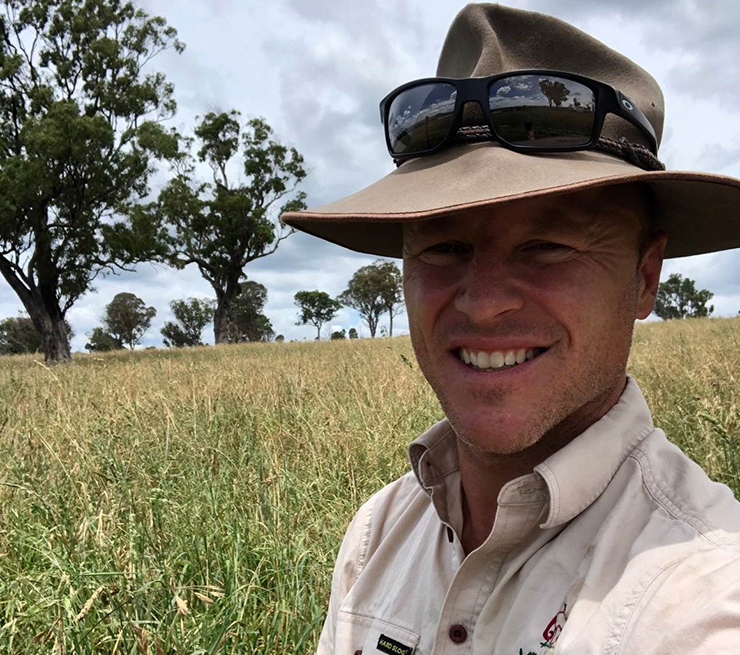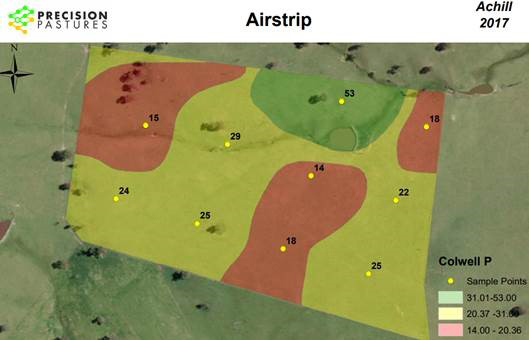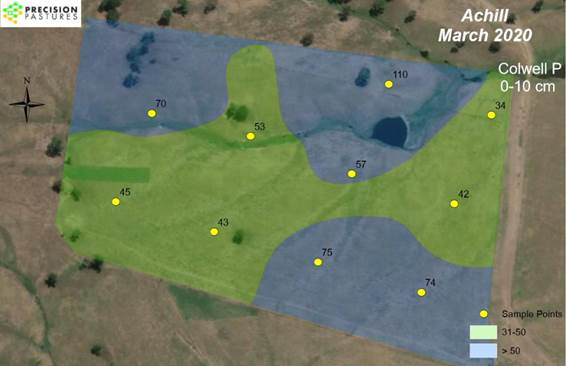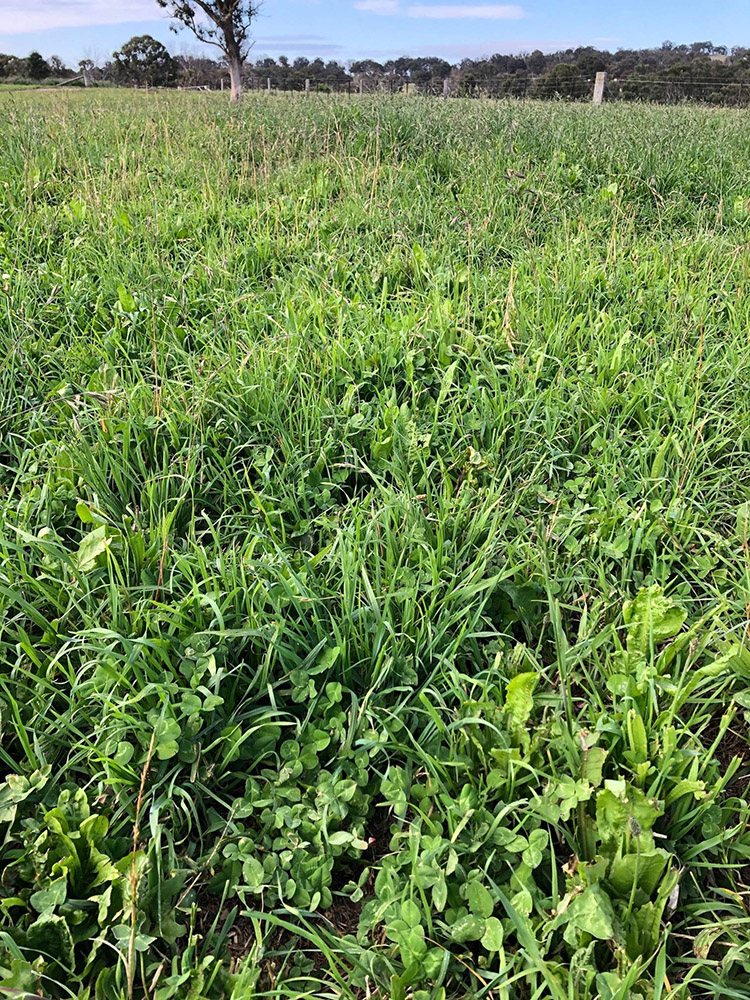
Sixth generation wool farmer and Managing Director of Achill Station, Charles Coventry operates a sheep and cattle property on the eastern side of Armidale, NSW in a joint venture with Italian luxury label, Ermenegildo Zegna. The successful joint venture began in 2014 and despite a run of below average rainfall seasons and only 278mm in 2019, the business today is on the path to being fully restocked and has continued to monitor soil nutrients.
Charles began soil testing on an annual basis 15 years ago and as a result has sustained a healthy carrying capacity, developed a cost effective fertiliser strategy and grown a diverse pasture mix to increase animal weight gain.
"We started soil testing to understand our nutrient balance in the soil to work out how much, and what type of fertiliser to apply," Charles said.
"Our soil testing has changed significantly over 15 years, there's been times where we've taken our own soil tests on repeat locations but more recently, we will identify what we want to test and then outsource the sampling and testing.
"We tend to do soil testing based on either grid testing a whole paddock or a cross section of a paddock.
"Currently we are more inclined to do a cross section of up to 300–400m where we take 4–6 tests along that line – then we will come back to that same spot and retest two or three years later."
Tapping into expertise and accessing specialist equipment were the key drivers behind Charles' decision to work with an advisor.
"The company we're using, Precision Pastures can do deep soil profile testing which we use to understand what our soil carbon position is.
"A lot of work is involved in the grid sampling and Precision Pastures have the specialist equipment to get the job done efficiently."
Squaring up the soil testing strategy
When it comes to Charles' soil testing strategy, he sets objectives approximately every five years.
"The objective we set 5–6 years ago was to increase the soil Phosphorus (P) levels so we were within the Phosphorus Buffering Index (PBI) across the whole of the farm," Charles said.
The Phosphorus Buffering Index (PBI) approximates a soil's ability to fix phosphorus (P). Soils with a high PBI quickly and tightly bind fertiliser P making it unavailable to plants. Low PBI soils can't lock-up much P, leaving most applied P for plant uptake.
"Soil testing identified the areas where we weren't within the PBI for optimum P levels. We have low PBI soils that average 100 so we aim to have our soil P levels at 30 mg/kg (Caldwell).
"It was important to get the application of fertiliser right to get ourselves within the peak P levels. Previously we have focused on SSP and feedlot manure, today we use MAP for maintenance.
"Now that we've achieved optimum P levels on the bulk of the farm, we've been more focused on using lime to increase our pH and maintenance on our P bank.
"The end goal of focusing on lime is to increase the pH levels to 5.2–5.5 (calcium chloride) across all our improved pastures to help combat our higher aluminum levels.
"By reducing our soil acidity and increasing our pH, we're allowing the soil to grow more productive grass as the root structures can access more of the nutrients and water."


Reaping the benefits
1. Healthy carrying capacity
As a result of the soil testing and getting the P levels right, Charles has seen a notable benefit in consistently maintaining a good carrying capacity at 8 DSE/ha over the winter, however this carrying capacity was cut by half by the peak of the drought.
"For example, compared to less developed country I own in the New England, based on our consistent fertiliser strategy at Achill Station we've been able to maintain a carrying capacity approximately 50% higher than country without the fertiliser history," Charles said.
2. Digging for the truth
"Soil testing is about capturing data to give you an objective view that allows you to make faster decisions. You can accelerate forward from an objective data point, but a hunch or a speculation about what might be below the ground isn't reliable," Charles said.
"Soil testing allows for more precise decisions. It's hard to ignore the facts when the soil test shows you're lacking in a particular nutrient."
3. Diversity of pasture species
The end outcome of soil testing is growing a larger amount and a greater diversity of improved pasture species across Achill Station.
"Our diverse improved pastures offer higher quantities of protein and energy, helping to increase animal weight gain and improve condition scores of ewes pre-joining and during pregnancy.
"We grow improved pasture species which are a mixture of species, but it's predominantly cocksfoot base mixture with clovers, chicory and plantain plus brome, prairie and phalaris grasses.
"It's important to have a diverse improved pasture mix because native pastures are not as effective in achieving higher weight gains, and the diversity in our improved pasture mix gives animals a choice at different times of the year."

4. Cost effective fertiliser strategy
"It's important to remember that our grazing operations are taking nutrients out of the soils so we need to understand what nutrients are missing, and provide those back into the soil in a cost effective manner," Charles said.
"Soil testing ensures you get the best return from your fertiliser budget because you can be targeted with nutrients and where you want to apply those nutrients.
"Soils without fertiliser might look after you in the short term, but the medium and long term is when you risk the consequences of the big crash – soil testing gives you the opportunity to address the problem before it gets out of hand."
Future soil testing
Charles plans to focus his soil testing strategy more on micronutrients as opposed macronutrients going forward.
"By grid testing, which we've been doing for three years in selected paddocks, allows us to do variable rate fertiliser application on improved pastures.
"Variable rate fertiliser application is very precise and therefore cost effective because we are only applying fertiliser to where it is needed rather than a blanket approach.
"There is now the technology allowing our soil tester to do the grid sampling and provide the file/data with the grid testing variable rate information to our fertiliser spreader, so the spreader can apply the fertiliser to where it's needed most."
Name: Achill Station Pty Ltd Location: Armidale, NSW Area in ha: 2560ha Enterprise: Superfine Merino wool and Angus cattle Livestock: 10,000 head Merino sheep, 1,000 head of cattle Improved Pastures: Cocksfoot based mixture with clovers, chicory, plantain, brome prairie grass Soils: Undulating country with trap soils, lighter clay loam Rainfall: 800mm |






